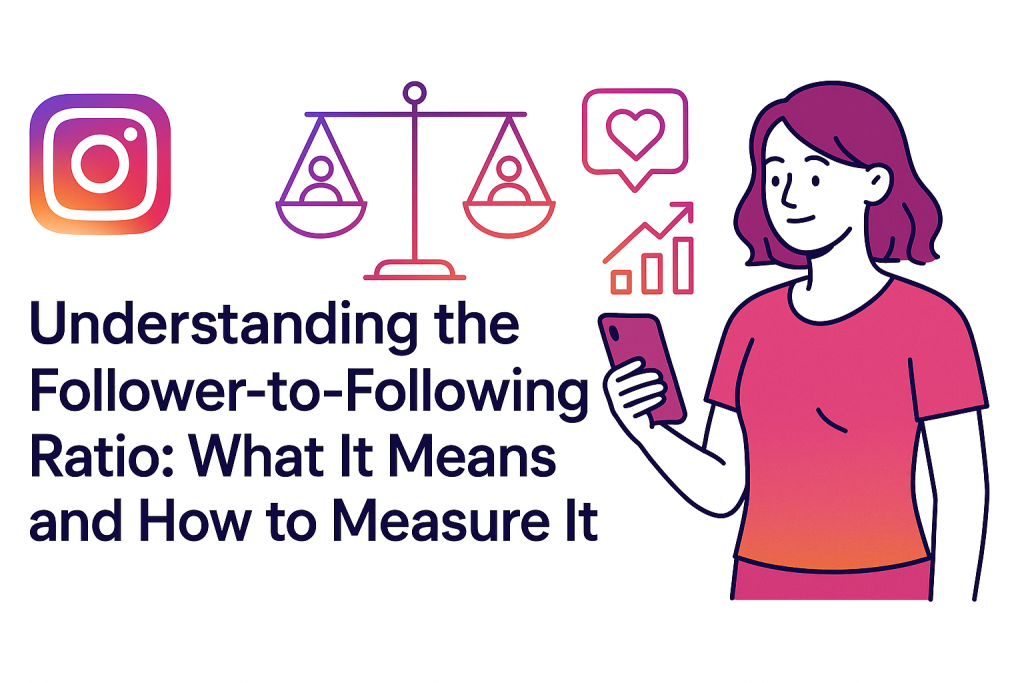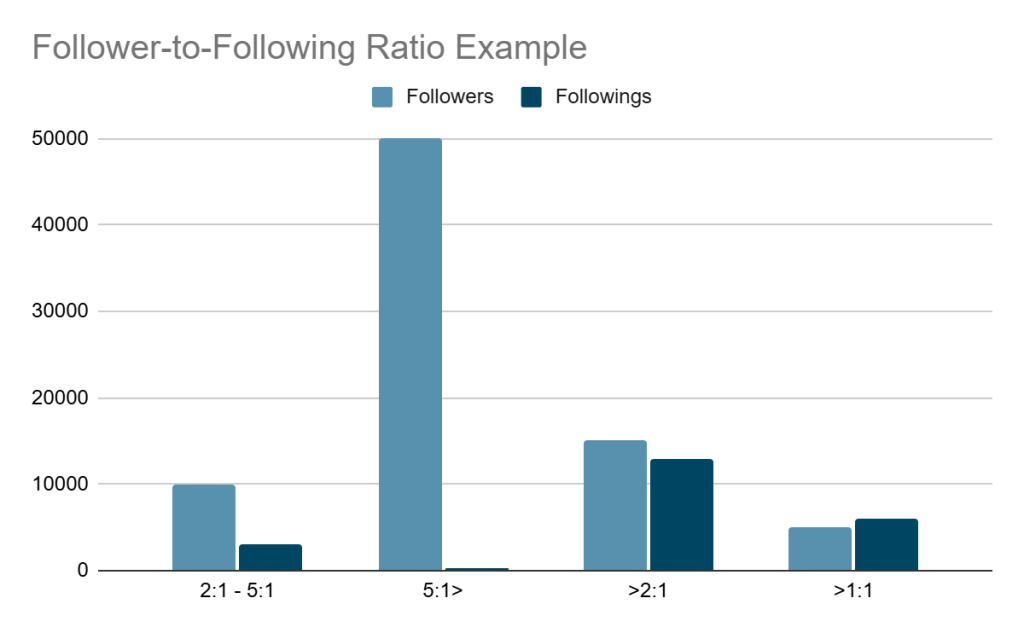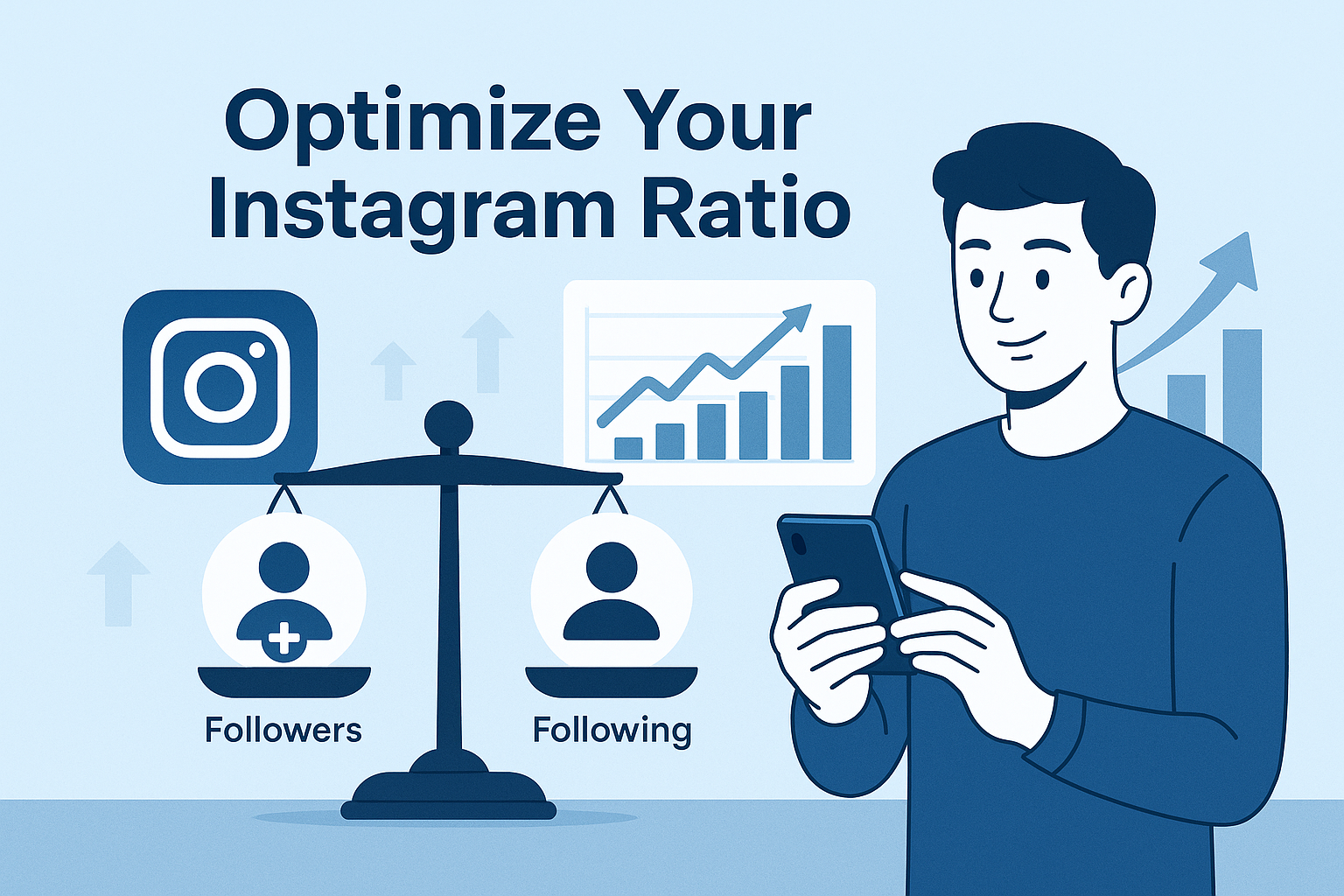The followers-to-followings ratio on Instagram is an important indicator of your reputation and influence on the social network. It shows how much your account is in demand and how interesting it is to the audience.
For users, this is a signal of high-quality and unique content, and for brands, it is a criterion when choosing partners for cooperation. It is a balanced and thoughtful ratio that helps you stand out in the ocean of accounts, increase engagement, and open the door to profitable collaborations.
In this guide, let’s explore in detail why it’s important to monitor this metric and how to maintain it at a level that promotes organic growth and strengthens your Instagram position.

Understanding the Follower-to-Following Ratio: What It Means and How to Measure It
The follower-to-following ratio is a key metric that reflects the ratio of followers to followers on your Instagram account. It’s easy to calculate: you need to divide the number of followers by the number of followed accounts. For example, if you have 3,000 followers and 600 followings, the result will be 5.
For influencers, this coefficient plays an important role because it demonstrates their popularity and credibility in the eyes of the audience. For brands, this is a kind of filter when choosing partners, allowing them to evaluate the quality and actual activity of the account.
*Note: The right balance helps build trust and social media reputation, stimulates Instagram engagement rate, and increases the chances of successful collaboration.
The Follower Ratio Formula Explained (With a Quick Example)
As already mentioned, the follower-to-following ratio is calculated very simply — you need to divide the number of followers by the number of followings. The formula looks like this:
[Followers ÷ Following = Ratio]
For example, if you have 10,000 followers and 1,000 followings, your ratio will be 10:1. This means that for every account you follow, there are ten people who follow you — such a balance is considered a sign of an influential and sought-after profile.
In the opposite situation, when you are followed in 10,000 accounts and there are only 1,000 followers, the ratio will be 0.1:1, which may signal a lack of interest in your content or attempts to artificially increase activity.
Maintaining a healthy ratio helps build audience trust and increases the chances of successful collaboration with brands.
Follower Ratio Standards: What Counts as Healthy on Social Media
A healthy Instagram follower-to-following ratio is an indicator that varies depending on the goals and account format. Usually, a ratio of 2:1 or higher is considered a good sign: each subscriber accounts for no more than half of the subscriptions. For influencers and brands with high engagement, the value can be even higher — 5:1 or higher indicates a strong position and authority.
Here is a good example of how different ratios affect account growth:

#1: A healthy ratio (2:1 – 5:1)
It is the optimal follower ratio balance for most accounts. It shows that you have 2–5 times more followers than followings. Personal blog with 10,000 followers and 3,000 followings (ratio ≈ 3.3).
Result: organic growth, stable engagement, and audience trust.
#2: High ratio (5:1>)
A sign of strong authority or a recognizable brand. The account has a lot more followers than followings. A well-known brand with 5,000 followers and 200 followings (ratio = 25).
Result: high level of trust, good reach, and loyal audience.
#3: Low ratio (>2:1)
It is often found in beginner accounts or those who actively follow in an attempt to attract attention. A beginner with 15000 followers and 13000 followings (ratio ≈ 1.1).
Result: a possible decrease in trust, the risk of low engagement, it is worth working on the content and audience.
#4: Very low ratio (>1:1)
This is typical for accounts with massive followings or without a clear strategy. Account with 5,000 followers and 6,000 followings (ratio ≈ 0.83).
Result: the profile is perceived less professionally, and there may be problems with organic coverage.
The Follower Ratio Banchmark Formula Explained (With a Quick Example)
Now let’s look at real examples to understand how ratio affects reputation and growth.
- High ratio (10:1 and above) — @nike has over 200 million followers and about 100 followings (ratio over 2 million:1). This level reflects a global brand with a massive audience and a minimum of followings (organic Instagram growth), which enhances its status and user trust.
- Average ratio (3:1 – 5:1) — @garyvee (Gary Vaynerchuk) — about 10 million followers and about 7 thousand followings. The balance shows active interaction with the audience and a conscious expansion of the circle of communication.
- Low ratio (about 1:1) — novice bloggers often have approximately the same number of followers and followings, which is associated with massfollowing to gain an audience. This approach may temporarily increase reach, but it reduces trust.
- Very low ratio (below 1:1) — accounts that practice aggressive follow/unfollow — the number of followings exceeds the number of subscribers, which negatively affects reputation and engagement.
So, let’s draw several important conclusions. First of all, the higher the ratio (assuming a high-quality audience), the better for reputation and trust. Also, it is not only quantity that is important, but also engagement. Finally, a healthy ratio is a reflection of an informed approach and high-quality content.
Thus, the success of an account is not only about ratio numbers, but also a comprehensive approach: high-quality content, honest interaction, and understanding of your audience.
How Your Follower-to-Following Ratio Influences Trust and Interaction Rates
The follower-to-following ratio is not just a number, but a kind of indicator of the influence and perception of an account by other users:
- Status formation at a glance
Accounts with a high ratio immediately evoke a sense of popularity. If a person is followed 100 accounts, and his audience exceeds 5,000, this creates the image of an expert, opinion leader, or brand with weight. This balance visually increases trust and stimulates interest.
- Algorithm behavior and audience reaction
Instagram’s algorithms focus on activity, but indirectly perceive the profile structure. A clean, untargeted audience, obtained without mass-tracking, interacts with the content more often. This increases the chances of getting into recommendations and improves coverage.
- Attitude to the engagement rate
Even with an impressive number of followers, it is important that they are engaged. If the activity is low, despite the high ratio, this raises doubts both among the algorithm and potential partners. A convincing ER speaks to the real value of the content and the lively interest of the audience.
Anyway, the Instagram follower ratio is a visual marker that influences perception, but it only works in conjunction with a high-quality audience and a sincere interest in your content.
Growth-Driven Strategies for Sustaining a Healthy Instagram Ratio
Do you want to maintain a balance between the number of followers and followings? Here are working strategies that will help you do it naturally and without hype:
- Be selective in your followings
Do not follow everyone in a row — it quickly reduces the perception of you as an expert. Follow those who are really interesting or useful to you — this approach emphasizes your awareness.
- Create content with value
Publications that solve problems, inspire, or simply delight the eye always attract a new audience. When the content “catches on”, followers come by themselves — without unnecessary promotion.
- Collaborations, not the hunt for numbers
Collaborate with bloggers or brands that are close to your niche and values. Such partnerships bring your audience — those who are really interested, not casual followers.
- Clean followings periodically
Once a month, go through the list and delete outdated or inactive accounts. This will not only improve the ratio but also make the feed more useful and inspiring for you.
A healthy follower ratio is a reflection of your account management style. Approach it wisely, build relationships, not just numbers, and the result will not take long.
Tips & Tricks to Monitor and Maintain a Healthy Social Media Ratio
Here are the key tips to help you effectively manage this balance between the number of followers and followings:
- Set clear account development goals — determine what you want to achieve: a high-quality audience, high engagement, or brand awareness. This will help you understand how many followings correspond to your tasks and how to build communication.
- Regularly monitor key indicators — pay attention to the activity of the audience: likes, comments, and story views. These metrics will help you assess how interested and engaged your audience is.
- Use professional analytical tools — Instagram Insights and third-party services (for example, Unfollowers Tracker, HypeAuditor, or Socialblade) provide detailed data on account growth and dynamics, show who has unfollowed and which publications work better.
- Abandon the follow-to-unfollow schemes — focus on creating valuable and interesting content, but not on various tactic schemes.
- Conduct regular following audits — delete inactive, irrelevant, or commercial accounts from followings. This helps keep the profile in order and improves the ratio, making it more transparent to the audience.
Follow these tips, and your profile will grow efficiently and steadily. This is a smart strategy and attentive attitude to your audience.
Conclusion
The follower-to-following ratio is an important element of your Instagram profile, which helps form a first impression and influences the perception of your reputation.
The main value of an account is an active, interested audience and high-quality content that evokes emotions and stimulates interaction.
Therefore, focus on creating content that reflects your values and solves the audience’s problems. Over time, the right balance of followers and followings will become a natural reflection of your work and professionalism.
As a result, the ratio is not an end in itself, but a tool that supports your image and promotes brand development.
F.A.Q.
How to calculate the ratio?
To calculate the ratio, divide the number of followers by the number of accounts you follow. A high value indicates your popularity and authority, while a low value may signal excessive followings or low engagement. For example, if you have 3,000 followers and 500 followings, then the ratio will be 6.
How long does it take to update the audit?
It is optimal to audit followers and followings every 1–2 months. This schedule helps you delete inactive or irrelevant accounts in a timely manner, keeping your profile clean and improving interaction with your audience.
What should I do if the ratio is too low?
If your ratio is too low, it’s time to rethink your strategy:
- Focus on creating content that is truly valuable and interesting to your audience — this will attract loyal followers, not casual ones.
- Clear the following list of inactive and irrelevant accounts.
- Avoid mass following — this approach does not work and reduces trust.
As a result, quality is more important than quantity, because it is sincere engagement that creates a strong and sustainable brand.
